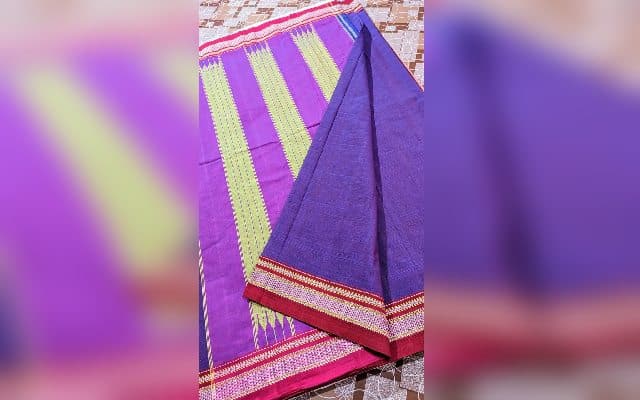Every saree-loving woman dreams of possessing at least one of that striped six yards – woven beautifully in handlooms of Ilkal Town in Bagalakote District. Ilkal sarees distinct for their pattern and weaving technique are a handloom legacy of North Karnataka.
A traditional, staple saree from North Karnataka, it has been loved by women from across the country and beyond borders.
Bagalakote has been the centre of education and trade for ages. However, Ilkal and Guldedgudda are primarily known for their textiles.
The centre of handloom weavers is right from the Chalukya dynasty. Almost every family is involved in weaving Ilkal sarees that are distinct in their pattern and weaving technique.
Ilkal saree weaving is found more in and around the villages of Kolhar, Ilkal, Kamatgi and Nidagundi located in Bagalakote District.
The body warp and the pallu warp are woven in a series of loop techniques called Kondi exclusive to the Ilkal saree weavers. In fact, this technique is carried out mostly by the women folk of the houses as it involves deft hands to create a loop and bind the body and the pallu parts.
Besides, the pallu is specially woven in red and silver colour. These sarees are usually woven in cotton, cotton silk or sometimes cotton with artificial silk and come in six, eight or nine yards. The pure silk sarees are worn usually on special occasions and some of them will have traditional Kasuti work as an embellishment on them.
Usually, sarees have a characteristic shade of dark indigo, purple, red and green with their traditional styles of pallus. Other features are it has traditional patterns with motifs of centipedes, dots and triangles. Pallu is given special importance as it is worn on the head as is the practice in North Karnataka.
The sarees are produced in pit loom, generally referred to as Kuni magga where traditional gomi or chikiparas borders of the sarees are generally woven.
History
The history of Ilkal Sarees can be traced back to 600 AD and the legacy still thrives, despite the challenges.
Goddesses have adorned the weave, several royal seamstresses and weavers have influenced the design palette, and hundreds of dark colours have been tried on them. Lakhs and lakhs of women have draped the saree. Since the saree is handwoven, it gets softer as it gets old. In many households in North Karnataka, old Ilkal sarees are the perfect choice for cradles as they make for soft bedding for babies.
Many women from various parts of India purchase sarees. But it needs 8 to 10 days to weave a single Ilkal saree, and all the family members work on it. In spite of all this, the weavers will get only Rs. 250 to Rs. 300 as profit per saree.
With the change in times, many handloom units have converted into power looms that are giving tough competition to traditional weavers. No doubt that handwoven sarees are more in demand, but traditional weavers don’t have the support to compete with power looms. Despite the Geographical Indication Tag, traditional weavers do not enjoy good business when compared to power looms.
However, they must be credited for carrying on the legacy and making every saree-loving woman’s dream materialise.

















